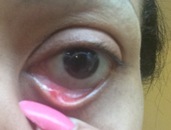
In February 2015, my optometrist insisted I try new soft lenses under the rigid lenses in my ‘piggy-backing system’. She suggested that these might provide better comfort and allow me longer wear time.
Within two weeks, I developed a small sty on the inner lid of my right eye.
Result-new soft lenses for piggy-backing fail.
Treatment? Remove all lenses AND KEEP THEM OUT!
But even after removing the lenses, the sty took about six weeks to disappear.
By then, I had accepted my new life.
My kids accompanied me to the grocery store to read the prices, I always took my big black handbag to be able to take my guide cane, my journeys back and forth to London stopped and my business came to a grinding halt.
The next few months consisted of the usual visits to the optometrist.
For some reason, she suggested we try a single, new soft lenses, which had apparently been able to help in even the most advanced Keratoconus cases. However, she cautioned me to “not get my hopes up”.
I truly wanted to get my hopes up.But alas, it was not to be.
The vision in my right eye was relatively good with the soft lenses, but I saw no letters on the Snellen chart from the left eye. I decided to not use the soft lenses, suggesting I try scleral lenses next. So, the optometrist booked in me for yet another fitting.
Frustrated about the havoc that had become my life, I decided to see my GP to insist on a referral to Moorfields Eye Hospital in London - one of the most prestigious institutions for eye health.
A DECISION TO TAKE ON MOUNT SNOWDEN
I needed something to lift my spirits so I decided to take on a physical challenge after reading about a Birmingham charity, Focus Birmingham, taking blind and partially sighted people to climb Mount Snowdon. The staff at Focus Birmingham were lovely and I felt pleased to help raise money to help the organisation. The children decided they wanted to climb Snowden too and I thought it was fitting for us to take it on together - because this (my sight loss) was a huge challenge that we all had to take on as well.
The climb is scheduled for April 23rd.
AN ONLINE DOCUMENTARY ABOUT KERATOCONUS
But I wanted to do more to raise awareness about Keratoconus, so I reached out to Tracy McCoy, Head of Department of Film, Media & Broadcasting at the University of Wolverhampton where I was a member of the Media Advisory Board with an idea for a short documentary about the condition.
She was excited and two weeks later, I pitched the project to 5 groups of students. The group would film a short web documentary about Keratoconus, my daily trials and join us summitting Snowden to capture the epic moment.
Within two weeks, I developed a small sty on the inner lid of my right eye.
Result-new soft lenses for piggy-backing fail.
Treatment? Remove all lenses AND KEEP THEM OUT!
But even after removing the lenses, the sty took about six weeks to disappear.
By then, I had accepted my new life.
My kids accompanied me to the grocery store to read the prices, I always took my big black handbag to be able to take my guide cane, my journeys back and forth to London stopped and my business came to a grinding halt.
The next few months consisted of the usual visits to the optometrist.
For some reason, she suggested we try a single, new soft lenses, which had apparently been able to help in even the most advanced Keratoconus cases. However, she cautioned me to “not get my hopes up”.
I truly wanted to get my hopes up.But alas, it was not to be.
The vision in my right eye was relatively good with the soft lenses, but I saw no letters on the Snellen chart from the left eye. I decided to not use the soft lenses, suggesting I try scleral lenses next. So, the optometrist booked in me for yet another fitting.
Frustrated about the havoc that had become my life, I decided to see my GP to insist on a referral to Moorfields Eye Hospital in London - one of the most prestigious institutions for eye health.
A DECISION TO TAKE ON MOUNT SNOWDEN
I needed something to lift my spirits so I decided to take on a physical challenge after reading about a Birmingham charity, Focus Birmingham, taking blind and partially sighted people to climb Mount Snowdon. The staff at Focus Birmingham were lovely and I felt pleased to help raise money to help the organisation. The children decided they wanted to climb Snowden too and I thought it was fitting for us to take it on together - because this (my sight loss) was a huge challenge that we all had to take on as well.
The climb is scheduled for April 23rd.
AN ONLINE DOCUMENTARY ABOUT KERATOCONUS
But I wanted to do more to raise awareness about Keratoconus, so I reached out to Tracy McCoy, Head of Department of Film, Media & Broadcasting at the University of Wolverhampton where I was a member of the Media Advisory Board with an idea for a short documentary about the condition.
She was excited and two weeks later, I pitched the project to 5 groups of students. The group would film a short web documentary about Keratoconus, my daily trials and join us summitting Snowden to capture the epic moment.
 RSS Feed
RSS Feed
